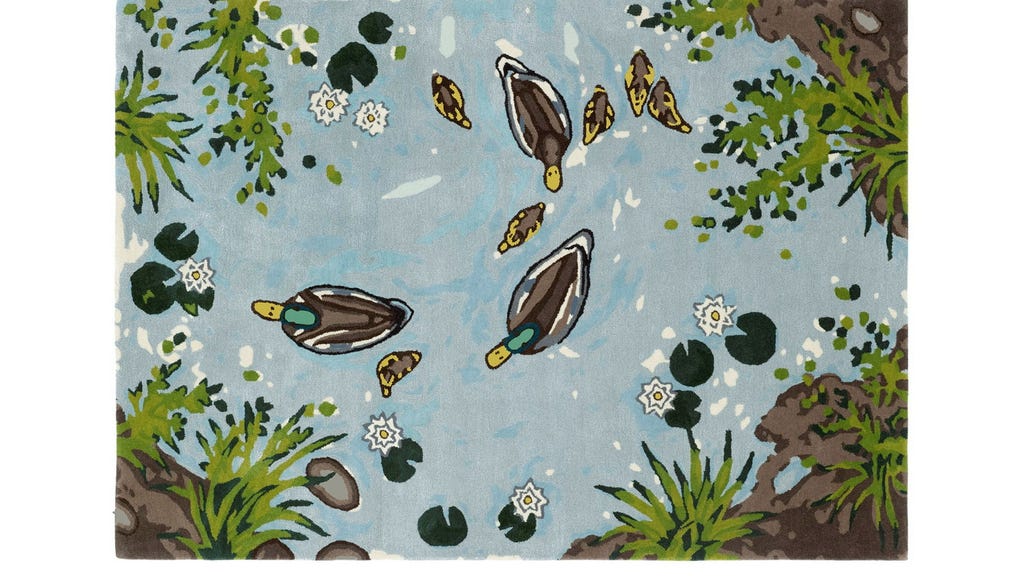Michael Asplund, known for his previous collaborations with the Hilma af Klint and Olle Bærtling foundations, producing rugs based on their artwork, embarks on a new venture: the ”Asplund/Åman art rag collection.” This project, curated by Jan Åman, involves the transformation of contemporary Swedish art into a unique collection of rugs. Asplund and Åman selected three prominent artists from the same generation, but with distinctly different artistic styles: Dan Wolgers, Cecilia Edefalk, and Ernst Billgren. The goal is to reimagine the rug’s place in modern aesthetics, elevating it from its current marginalized position and recognizing its historical prominence as a significant artistic element. The project also aims to explore the creative process of translating two-dimensional art into the tactile medium of textile.
The collaboration resulted in 17 limited-edition rugs, varying in size and design, each reflecting the artists’ individual styles and approaches. The process, documented in a companion book featuring transcribed conversations between Åman and the artists, unveils the challenges and discoveries encountered during the transition from canvas to rug. Billgren, for instance, grapples with the shift in perspective when a piece moves from the wall to the floor, requiring the viewer to look down upon it. Wolgers, characteristically, embraced his ”doing nothing” approach, which led him to the creation of ”ready mades” sourced from online searches, including children’s answers to various questions, translated into unexpected and intriguing rug designs. Edefalk faced the intricate task of converting her nuanced paintings into textile form, a process demanding precision and a deep understanding of material translation.
Edefalk’s large-scale sun painting encountered production delays and won’t be ready for the opening exhibition. However, two other pieces, ”Dom” and ”Charm,” adapted from a series of word signs she created during her time at the Royal Institute of Art in the 1980s, will be featured. Edefalk, having been named the Märta Måås-Fjetterström Artist of the Year in 2008, possesses prior experience in textile art creation. Her previous collaboration with the Märta Måås-Fjetterström workshop in Båstad instilled in her an appreciation for the collaborative process with skilled craftspeople, a sentiment that resonated strongly with this current project.
The ”Asplund/Åman art rag collection” opening exhibition will take place at Helix in Stockholm. While most of the rug collection will be on display, two notable exceptions are Edefalk’s sun-themed rug, still in production, and Billgren’s ”Paintings at an Exhibition,” which will premiere at his solo exhibition at the Nationalmuseum in April. The showcased rugs represent a diverse range of artistic expression, transformed into the medium of hand-knotted and hand-tufted rugs crafted in India. Following the initial two-week exhibition at Helix, the collection will be displayed at selected locations throughout Stockholm during the February design week. All rugs are available for purchase, with prices starting at 40,000 SEK and upwards, offering collectors a unique opportunity to acquire these exceptional pieces of art.
The project highlights the exciting confluence of contemporary art and traditional craftsmanship, bridging the gap between different artistic disciplines. The rugs themselves become a testament to the artists’ creativity and the skilled artisans’ ability to translate complex artistic visions into tangible, functional works of art. This collaboration not only reimagines the rug as a contemporary art form but also provides an insightful exploration of the creative process and the challenges of translating artistic ideas across mediums.
The ”Asplund/Åman art rag collection” serves as a platform for innovative artistic exploration, celebrating the unique perspectives of three celebrated Swedish artists. The project’s meticulous documentation, through the accompanying book, further enriches the appreciation of the creative journey and the intricate dialogue between artist, curator, and artisan. This initiative, marked by both artistic innovation and meticulous execution, promises to leave a lasting impact on the perception and appreciation of rugs as a significant artistic medium.














